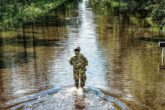September 09, 2021
Confronting Chaos: a New Concept for Information Advantage
“It failed miserably.” With these words, Gen. John Hyten dropped a bomb on the Defense Department’s vision for fighting China and Russia, the joint warfighting concept. He told a defense industry group that an adversary red team “ran rings around” a U.S. team using the concept in an October 2020 wargame. Some defense thinkers claimed this was no big deal. However, although American teams lose wargames all the time, this is, in fact, a very big deal.
The joint warfighting concept is a top priority for the Pentagon. It’s supposed to align the armed services’ operational thinking and inform future force development. The Defense Department has been developing the concept for years, and yet it still failed. More worrying is why it failed. According to Hyten, the concept assumed U.S. forces could achieve information dominance in a great-power conflict, akin to what the American military attained during the 1991 Gulf War. That assumption is fatally flawed.
The side that can deal with chaos and operate more effectively with degraded systems will likely seize the initiative.
Nearly three years after the 2018 National Defense Strategy identified gaining and maintaining information advantage as a critical mission, thinking among Defense Department leadership about information advantage remains muddled. They don’t understand what it means, what it requires, or how to achieve it. This intellectual vacuum permits “zombie ideas” like information dominance to shamble onward while the department and armed services treat technology as a panacea for their operational and strategic headaches.
There’s an exit from this morass. The Pentagon should accept that the post-Gulf War era of imagined U.S. information dominance is over and abandon the idea of connecting “every sensor to every shooter.” Instead, it should design its concepts around the fact that degradation, disruption, and disorder are endemic features of warfare and focus on connecting enough sensors to enough shooters under combat conditions. The department should build new networks and data processing technologies, but it should also recognize the critical role of humans in the emerging “techno-cognitive confrontation” with China and Russia. Gaining information advantage requires accompanying new technologies with updated command philosophies, organizational constructs, and training paradigms that will allow U.S. forces to prevail in the chaotic conditions that will characterize great-power conflicts. The alternative is more failure and possible military defeat.
Read the full article from War on the Rocks.
More from CNAS
-
It’s Time for a True Industrial Strategy for American National Security
For an industrial strategy to work, the president must make it a White House priority that pulls together all elements of national power....
By Becca Wasser & Mara Rudman
-
Sharper: Allies and Partners
Amid intensifying geopolitical challenges, the United States is finding new ways to address security issues by cultivating and strengthening alliances and partnerships. How ca...
By Gwendolyn Nowaczyk & Charles Horn
-
How We Survive Ep 5: Wargames
Dr. Ed McGrady, Adjunct Senior Fellow for the Defense Program at CNAS, joins the show to discuss how climate began to factor into humanitarian crisis war games as far back as ...
By Dr. ED McGrady
-
Wars Are Not Accidents
The road to conflict is an action-reaction process. Leaders decide whether and how to respond to a rival’s moves, and they often search for ways to lower the temperature. Esca...
By Erik Lin-Greenberg




